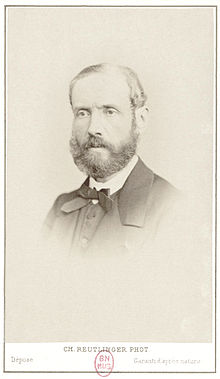Louis Lefébure-Wély
Louis James Alfred Lefébure-Wély (born November 13, 1817 in Paris ; † December 31, 1869 there ) was a French organist and composer .
Life
Lefébure-Wély was born in Paris as the son of the organist Isaac François Lefèbre (later name changed to Lefébure). He studied organ music at the Paris Conservatory with François Benoist (1794–1878), one of the most renowned organists of his time, and piano with Pierre Zimmermann . Lefébure-Wély followed in his father's footsteps and replaced him as organist at the Paris church of Saint-Roch. In 1847 he moved to the La Madeleine church (also Paris) and played there from 1847 to 1857 on the newly built Cavaillé-Coll organ. At that time, Lefébure-Wély enjoyed great popularity in France. He was known as a brilliant improviser and composer who knew how to effectively use the new possibilities of the modern organ. From 1857 to 1863 he was not an organist. After completing the Cavaillé-Colls organ, the largest with 100 registers , he was committed to the church of St-Sulpice de Paris until his death in 1869 . He was succeeded by Charles-Marie Widor . Lefébure-Wély died on New Year's Eve 1869 and is buried in Paris in the Père Lachaise cemetery not far from Chopin .
plant
Lefébure-Wély's organ treatment is characterized by a sophisticated style that is popular with the Parisian bourgeoisie and often scolded by the reformers of church music, combining popular themes such as can-can or even elements of salon music and operetta with the style of French Romanticism . He often uses pleasing, catchy motifs for his themes and gives detailed instructions on registration in the musical text. The concert bolero (“Boléro de concert”) in G minor Opus 166 is one of his best-known organ compositions. He also composed numerous pieces for piano and harmonium . His main work is the collection "L'Organiste Moderne" ("The modern organist"), published in 12 deliveries by the Richault publishing house. It contains liturgical organ music that Lefébure-Wély composed for the Catholic Mass and Vespers of his time. He often titled his works with the direct function they fulfill in worship. Typical names include "Sortie" (music to the exit), "Offertoire" (instead of or after the offertory ) and "Communion" (music accompanying communion ). The complete series “L'Organiste Moderne” is a reprint of the original edition from the music publisher Dr. J. Butz appeared.
Selection of works
- Six Offertoires op.34 (approx. 1857).
- Six Grands Offertoires op.35 (ca.1857).
- Six Morceaux pour l'Orgue, contenant 3 Marches et 3 Élévations op.36. Graff (1863).
- Meditaciones religiosas op. 122. Met opschrift: À Sa Majesté la Reine Doña Isabel II. (1858)
- L'Office Catholique. 120 Morceaux divisés en dix Suites composés pour l'harmonium ou l'orgue à tuyaux, op.148. Homage to Monseigneur de la Bouillerie, Évêque de Carcassonne. Régnier-Canaux, sd (1861).
- L'Organiste Moderne. Collection de Morceaux d'Orgue dans tous les Genres. En 12 livraisons. Homage to Mr. l'Abbé Hamon, Curé de St. Sulpice. Ces Morceaux onté écrits sur les Motifs improvisés aux Offices de St. Sulpice. (1867-69).
Web links
- Works by and about Louis Lefébure-Wély in the catalog of the German National Library
- Sheet music and audio files from Lefébure-Wely in the International Music Score Library Project
- Louis-James-Alfred Lefébure-Wely. In: culture.gouv.fr. November 15, 1999(German).
- Claus Fischer: The "Offenbach of the Organ": On the 150th anniversary of the death of Louis Lefébure-Wély. (mp3, 10.7 MB, 5:52 minutes) In: SWR2 broadcast “Cluster”. December 31, 2019 .
| predecessor | Office | successor |
|---|---|---|
| Charles-Alexandre Fessy |
Titular organist of the La Madeleine organ 1842–1846 |
Camille Saint-Saëns |
| Georg Schmitt |
Titular organist at the Church of Saint-Sulpice (Paris) 1863–1869 |
Charles-Marie Widor |
| personal data | |
|---|---|
| SURNAME | Lefébure-Wély, Louis |
| ALTERNATIVE NAMES | Lefébure-Wély, Louis James Alfred (full name) |
| BRIEF DESCRIPTION | French organist and composer |
| DATE OF BIRTH | November 13, 1817 |
| PLACE OF BIRTH | Paris |
| DATE OF DEATH | December 31, 1869 |
| Place of death | Paris |

